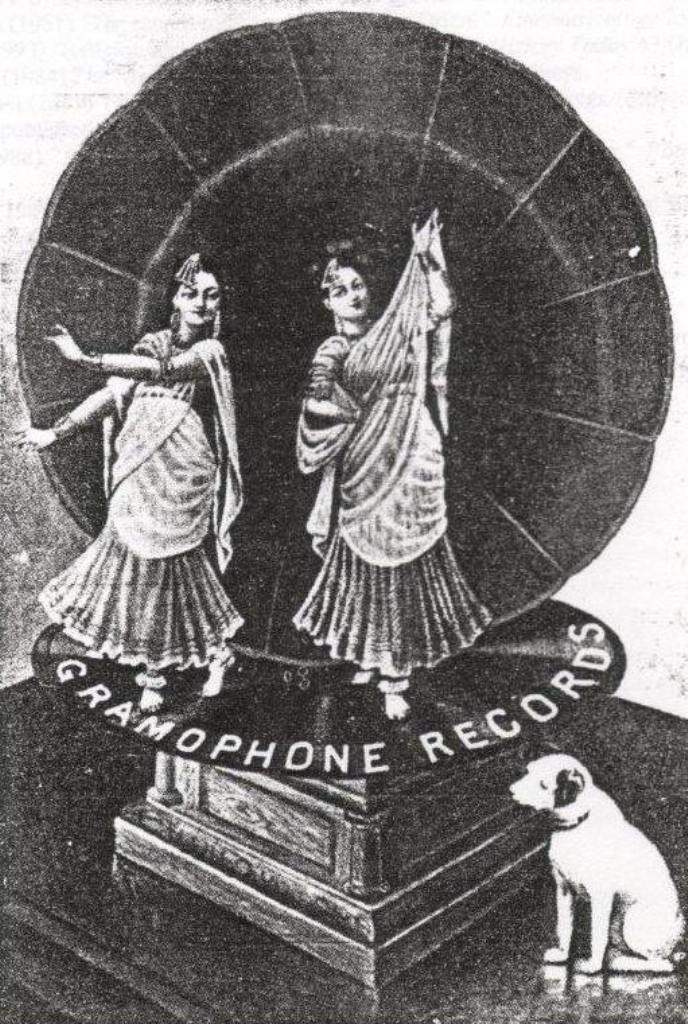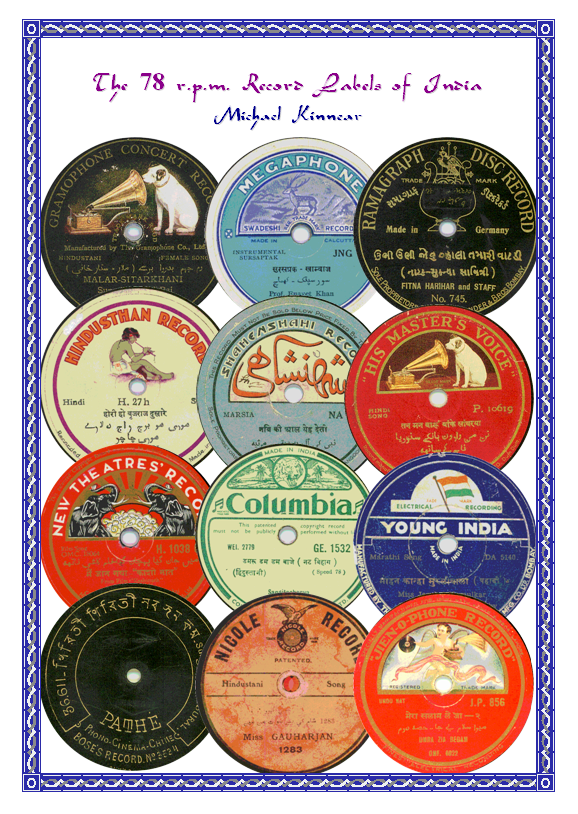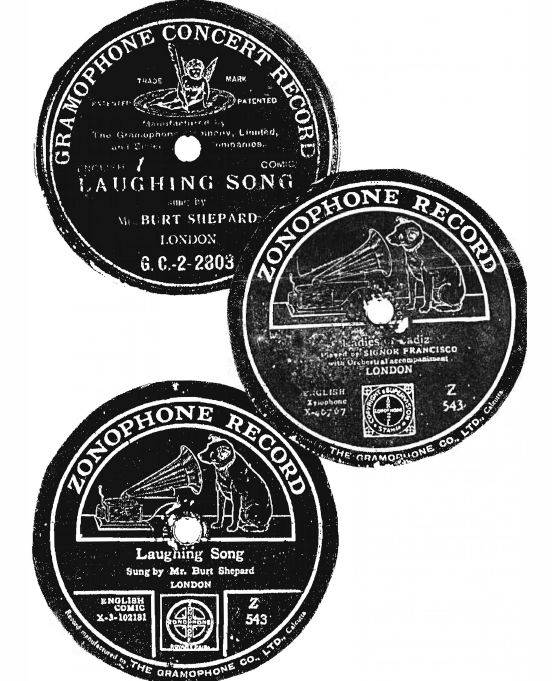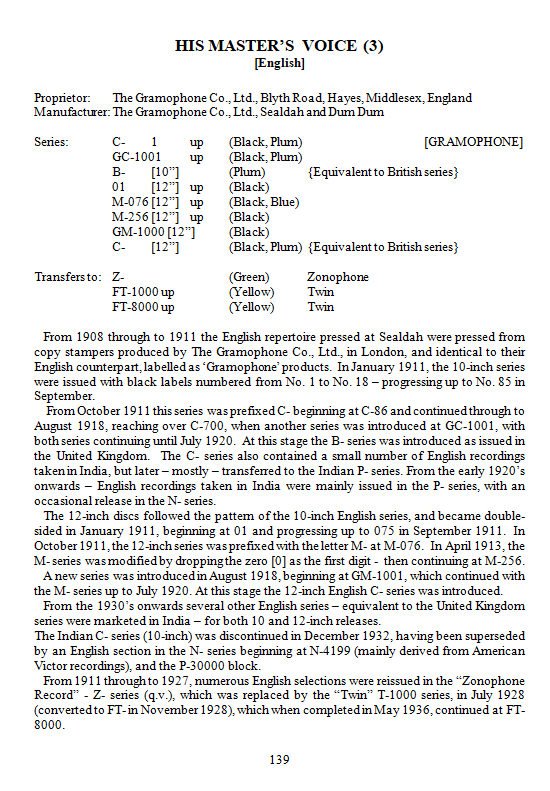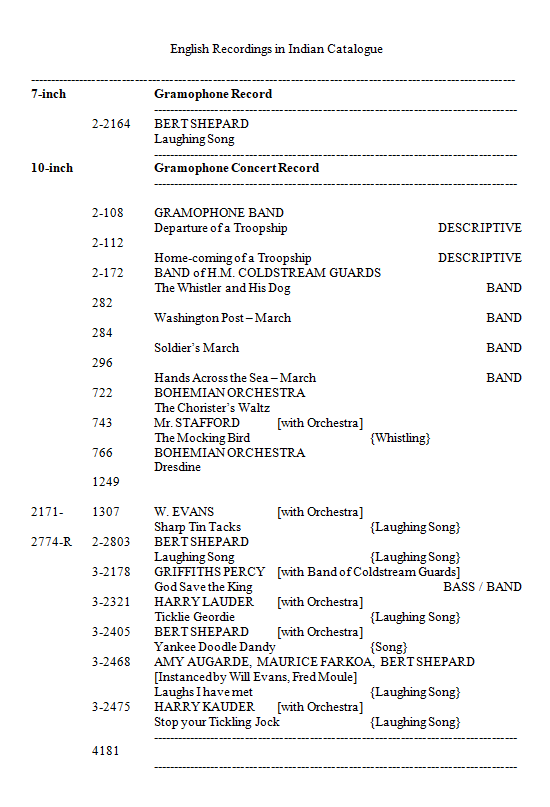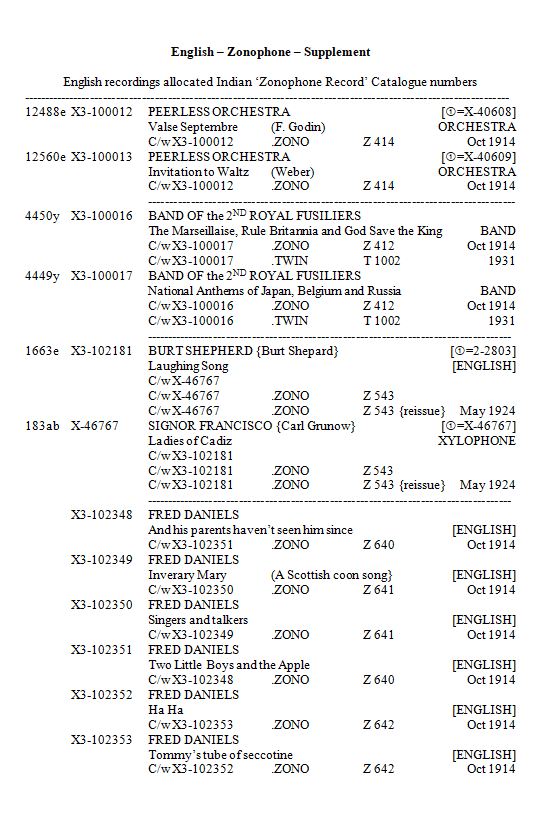Part ONE
ENGLISH INDIAN GRAMOPHONE NUMBERS
By Frank Andrews and Michael Kinnear, originally Published April 1992
Part TWO
“ENGLISH” RECORDINGS IN THE INDIAN CATALOGUE
by Michael Kinnear
Published in ‘The 78 rpm Record Labels of India’ 2nd Edition, 2016, with updated information on the above article ‘English Indian Gramophone Numbers’
The ‘first’ printed Catalogues of Indian repertoire were published in 1905 and include editions in the Bengali, Hindustani, Gujarati, Punjabi, and ‘Nagri’ (Hindi) languages. There was also a ‘South Indian’ catalogue which included Tamil, Telugu, Malayalam and Sanskrit recordings.
Apart from the ‘South Indian’ catalogue all of the editions of the ‘Indian’ catalogue also included a page of ‘English’ recordings which had been selected for the disc record market in India. This listing of a few dozen single side recorded idscs remained fairly static for a couple of years and except for a couple of recordings by M. Bruce Gordon and W.S. Buke – all other ‘English’ titles were marked in India under their ‘original’ number allocations. This numbering procedure continued up until the end of 1910, by which time The Gramophone Co., Ltd., had been pressing ‘English’ records at their factory at Sealdah, Calcutta.
(Frank Andrews now describes how the 10 inch and 12 inch ‘English’ series were numbered in their own series – using Indian numerical blocks.)
10 inch – numerical – to C series
“Beginning in January 1911 – the 10” inch Double-Sided discs were issued with Black labels and plain numbers from No. l up to No. 18. Supplements took the numbers to No. 85 with the September 1911 issues.
From October 1911 the numbers became prefixed “C” with new issues at C-86 onwards and the new catalogues afterwards showed all earlier numbers had partaken of the “C” prefix.
The “C” series progressed into the C-700’s when in August 1918 another series for double-sided discs was introduced at GC-1001 – and BOTH series continued until the July 1920 issues when the India catalogues of English recordings introduced new recordings under the “B” prefixed numbers as issued in the United Kingdom, but subsequent catalogues still contained some of the 10 inch “C” series and “GC” series.
12 inch – numerical – to M series
The 12 inch double-sided discs had also begun in January 1911 with 01 and 02 and they progressed in the supplements to 075 by September 1911. In October 1911 these 12 inch discs began to take an “M” prefix at M-076 and the following complete catalogues showed the earlier numbers then had the “M” prefix.
In April 1913, with the highest number issued being M-0255 the numbering was continued by dropping the zero (0-) as the first digit and so the lowest number April 1913 number was M-256. All previous issues then began to be catalogued as simply “M” prefixed without the zero. A new contemporary series, beginning with GM-1000, was begun in August 1918.
The 12 inch “M” series and the “GM” series continued through to July 1920 when as with the 10 inch double-sided discs – a new series was introduced with “C” prefixed numbers as issued in the United Kingdom.
The discs (both sizes) were all Black labelled until December 1916, when the cheaper plum labels were introduced, sharing the number series with the Black labels in both sizes. The July 1920 ‘plum’ label supplement had the discs continuing with The Gramophone Co., Ltd., Calcutta’s own 10 inch “C” series, but the Electric & Musical Industries, Ltd,, supplement shows that the “B” had been substituted for “C” although retaining the number series – then in the C-870’s, but second thoughts prevailed and the United Kingdom sourced “B” numbers were hand written in by the side in the pages of the catalogues, except for C-874 – the highest 10 inch (Indian) “C” issued.” [F.A.]
Record collectors of ‘English’ repertoire – issued on GRAMOPHONE CONCERT RECORD (10″), GRAMOPHONE MONARCH RECORD (12″) or ZONOPHONE RECORD (10″ and 12″) and also HIS MASTER’S VOICE (Black label – numerical and “C” series 10″ and ‘plum’ label) as described above – might be interested to examine these records very closely, Most issues in India were produced from ‘daughter’ stampers and are identical to the United Kingdom issues having been manufactured from ‘duplicated’ (or daughter) metals that are from the same stampers as the original English issue. Occasionally other or alternative ‘takes’ were used to manufacture the discs in India – thus the Indian pressings of such discs are unique in that they are slightly different from the United Kingdom issues.
Apart from utilizing The Gramophone Co., Ltd.s resources, The Gramophone Co., Ltd., in India also utilized matrix stocks and stampers from Deutsche Grammophon-A.G., Berlin, and Victor Talking Machine Co., Camden, New Jersey, United States of America. The ‘Victor’ source often turns up matrix stocks and stampers that were NOT utilized in America. Although it is a complex issue a number of the Indian “C” issues are in fact ‘alternative’ issues to those of the ‘original’ issues in their country of origin.
An example of the variation within pressings might be gained from the fact that – Indian HMV – C-403 is drawn from – English HMV – B297 – which has its origin from Victor matrix stocks. Amongst a number of other issues, these recordings from Victor of Hawaiian Guitar Duets by various artists – are listed in the regular Indian ‘nagri’ catalogues – as being (anonymous) recordings described as – “Sitar Aur Veena” – suggesting that these are performances by Indian musicians – but in fact they are Hawaiian Guitar Duets.
Even up to the main Indian ‘nagri’ for 1921, the listings show that C-74, C-253, C-254, are Black Label, while C-46, C-63, C-70, etc are ‘plum’ label issues. More significant that amongst a number of ‘English’ recordings taken in India – is that C-253, and C-254, were the only issues to have been recorded in India ——– and originally having ‘English’ single-face numbers – and entered to the ‘English’ Indian “C”” series (unless something else is discovered) all other recordings taken in India of English repertoire were allocated to the regular Indian “P” series for 10 inch or “K” series for 12 inch that is up until 1929.
It should be noted that up until 1929, ALL records issued by The Gramophone Co., Ltd., in India had been manufactured at its factory which was located at 139 Beliaghatta Road, Sealdah – not one mile from the heart of Central Calcutta, very close to one of the busiest railway terminals in India. ALL records – whether they be of English or Indian repertoire – or other Asian repertoires manufactured at Sealdah – will have printed upon the labels – (made by) – The Gramophone Co., Ltd., Calcutta., on the lower part of the label. From 1929 onwards the printed labels will read as (made by) The Gramophone Co,, Ltd., Dum Dum, – indicating that the factory of The Gramophone Co., Ltd., in India had been relocated to Dum Dum on the northern outskirts of Calcutta.
N series – beginning as ZONOPHONE RECORD
The English repertoire of the ZONOPHONE RECORD was first introduced in India in March 1908, and at first the pressings of the ZONOPHONE RECORD as marketed in India were manufactured at Hanover, Germany, and were single-side recorded discs ONLY, the 10″ selling in India for Rs.1-14, The Gramophone Co., Ltd., in India, marketed these discs through what they described as their “Zonophone Department”.
By October 1910, the Indian repertoire of the ZONOPHONE RECORD had been placed on the market by The Gramophone Co,, Ltd., – as DOUBLE-SIDED discs ONLY – selling for 2 Rupees. The first few Indian repertoire ZONOPHONE RECORD double-sided discs are believed to have been manufactured at Hanover, Germany or at Hayes, England – as the FIRST pressings are labelled as being manufactured by the International Zonophone Company. (without the stamping – Made in Calcutta) by January 1914, all ZONOPHONE RECORD issues of Indian repertoire that had previously been issued under their single-face numbers (X3- …… ) were given a double face number with an “N” prefix – the first double face number being N-392 – and retaining the single face number as well.
Z series – ‘English’ ZONOPHONE RECORD
With the English repertoire on Indian ZONOPHONE RECORD’S the single-face numerical series (which were by then all double-sided discs) were given a “Z” prefix for the 10 inch discs and “A” prefix for the 12 inch discs.
The ONLY ‘English’ recording to be allocated an Indian ZONOPHONE RECORD number (at this stage) was X3-102181 (matrix – 1663e) “Laughing Song” – by Burt Shepard / coupled with X-46767 (matrix – 183ab) “Ladies of Cadiz” played by Signor Francisco (sic!) – this same coupling was reissued as Z-543 during 1914.
The “N” series progressed as Indian ZONOPHONE RECORD issued up to N-1485 when in January 1925, the “N” series was transformed into HIS MASTER’S VOICE “Green Dog” label and assumed “Gramophone” coupling numbers.
The monthly supplements of issues on HMV “Green Dog” label progressed at the rate of about 10 to 12 issues per language – and included intermittent ‘blocks’ of European recordings – eventually changing from HMV “Green Dog” to “Plum Dog” – a process which at this stage of research still requires some sorting out, because even though the HMV “Green Dog” label gradually progressed to “Plum Dog” The Gramophone Co., Ltd., also retained a number of Indian repertoire titles as “N” prefixed “ZONOPHONE” labelled discs within the “N” series of “Green Dog” and “Plum Dog” labelled discs – the significant factor of which was the selling price of the “N” series.
The Indian “N” prefix series -was still active into the 1960’s in India, by which time the numbers are up in the N-150,000 range, within which are numerous ‘blocks’ for an amazing variety of repertoires. By the end of 1933 the “N” series had changed permanently from “Green Dog” to “Plum Dog” and (since 1929) show The Gramophone Co., Ltd., Dum Dum, as the manufacturer.
Several record collectors of English repertoire – made at “Calcutta” and “Dum Dum” in the “N” prefix series like to think that the “N” series was “exclusively” for ‘English’ recordings but as the above little narrative reveals a very different story.
FRANK ANDREWS and MICHAEL KINNEAR
Part TWO
“ENGLISH” RECORDINGS IN THE INDIAN CATALOGUE
by Michael Kinnear
Published in ‘The 78 rpm Record Labels of India’ with updated information on the above article ‘English Indian Gramophone Numbers’


